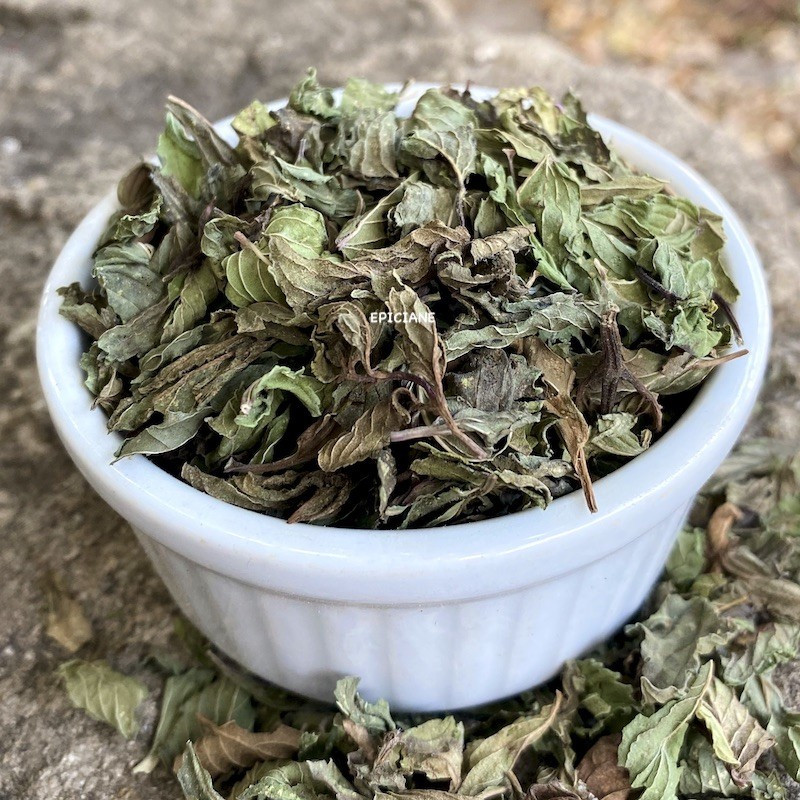
Reference: 20715402


Its flavor is strong and very refreshing, similar to the chewing gum it often flavors.
It’s wonderful in tea and infusions, but also delicious in tabbouleh and Asian dishes.
 Delivery
Delivery
Mondial Relay
 Returns
Returns
See conditions
 Payments
Payments
100% secure
Livré en sachet refermable
Uses in Cooking and Beyond:
Peppermint can be infused, either alone or with tea. It’s also excellent in summer salads, paired with tarragon, olive oil, and garlic, as well as in tabbouleh. You’ll enjoy it in ice creams and fruit salads, too. When fresh, peppermint is often used to accompany spring rolls (nems).
Peppermint is actually a spontaneous hybrid between water mint and spearmint. Its leaves have a strong, peppery flavor. It’s less commonly used in cooking than spearmint, but it is highly valued in essential oil production and the food industry for flavoring candies, toothpaste, chewing gum, confectionery, and alcoholic beverages like Jet 27, similar to spearmint.
Who am I?
Origin: Egypt
Scientific name: Mentha piperita
Common names: Peppermint, English mint
Peppermint is a herbaceous plant from the Lamiaceae family, a spontaneous hybrid between two varieties, including spearmint. Like all mints, it prefers moist, shaded, cool locations and non-calcareous soils. It was first cultivated in England in the 17th century, where the hybridization occurred and it was named "peppermint." It was already valued for its refreshing qualities. Some specimens are still preserved in the British Museum’s herbarium. Even then, it was considered a digestive and aromatic plant.
Harvest takes place from June to October. The plant blooms in summer but produces few seeds, mainly spreading through underground stolons, which can make it invasive in favorable conditions. Today, peppermint is naturalized in many countries, from northern to southern Europe, North America, and even Australia.
The essential oil is extracted from the leaves, which are rich in menthol, through steam distillation. Peppermint has antiviral, antibacterial, and even antitumor effects. It also possesses digestive, tonic, and respiratory decongestant properties, even more so than spearmint. In high doses, it can be stimulating and is often contraindicated when taking homeopathic remedies.
A Little History of Mint:
In ancient Babylonian, Egyptian, and Greco-Roman cultures, several varieties of mint were already known and used. The name Mentha comes from the ancient Greek "minthe" and the Latin "menta." Mint has been found in ancient Egyptian tombs, indicating that its various properties were already known at that time.
Data sheet
 Philippe D.
Philippe D.
?

 Philippe D.
Philippe D.
?

Reference: 20715402
Reference: EPI2301013
Reference: 10M6821604
Reference: ecorcecitronH
Reference: 26545D
Reference: 6470
Reference: cardamomeverteE
Reference: 3913
Reference: SPW06600
Reference: badianeM
Reference: camomilleRom
Reference: badianeE
Reference: bergamote
Reference: 2M6273801
Reference: verveine
Reference: 6N7456401
Reference: EPI230204

Its flavor is strong and very refreshing, similar to the chewing gum it often flavors.
It’s wonderful in tea and infusions, but also delicious in tabbouleh and Asian dishes.